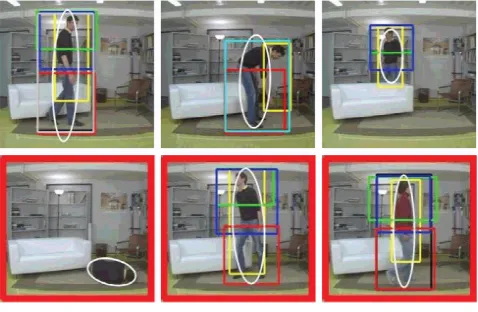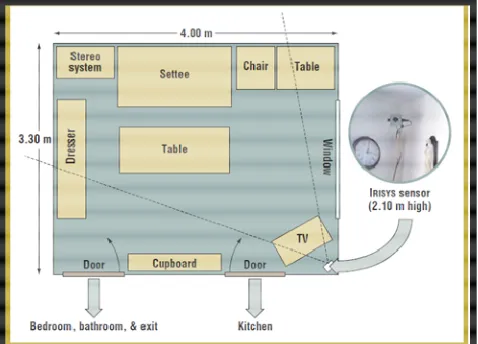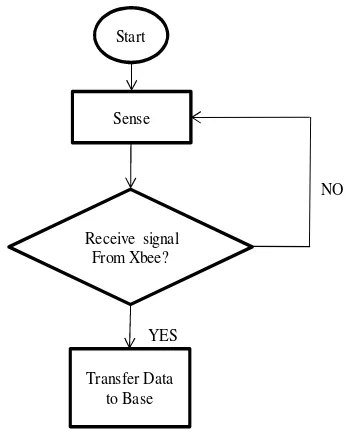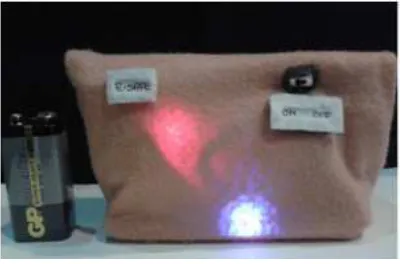__________________________________________________________________________________________
ZIGBEE-BASED SMART FALL DETECTION AND NOTIFICATION
SYSTEM WITH WEARABLE SENSOR (e-SAFE)
Vigneswara Rao Gannapathy
1, Ahamed Fayeez Bin Tuani Ibrahim
2,
Zahriladha Bin Zakaria
3, Abdul Rani Bin Othman
4, Anas Abdul Latiff
5 1, 2, 3, 4Lecturer, Department of Electronics and Computer Engineering,
5Lecturer, Department of Telecommunications
Engineering, Universiti Teknikal Malaysia Melaka, Melaka (UTeM), Malaysia,
[email protected], [email protected], [email protected], [email protected],
[email protected]
Abstract
Fall is one of the serious health issues among elderly population in Malaysia. In the event of a fall, a strong impact may be inflicted on the elderly causing severe injuries or even death. Another research by the National Institutes of Health found that 67% of elderly who fall and fail to seek help within 72 hours are unlikely to survive. Current Personal Emergency Respond System (PERS) often employs the use of a manual emergency button. However this approach may not be useful if the fall victim become unconscious or even not be able to move to reach the emergency button. In addition, such as this approach also requires more time and inadequate to notify and seek for immediate help. This paper attempts to design and implement a smart fall detection system for real time notification known as e-SAFE. This system will automatically detect a fall and notifies the incident instantly to internal and external correspondence. The e-SAFE equipped with a wearable accelerometer sensor, microcontroller, ZigBee transceiver module and Global System for Mobile communications (GSM) device. The in-house correspondence will be notifies though the ZigBee technology, meanwhile the external correspondence will be notified through GSM. Once a fall has been detected by e-SAFE system, a Short Message Service (SMS) and an E-mail will be sent to predefined contacts which is stored in the system. This system will provide a path toward independent living for the elderly while keeping them save.
Index Terms: Emergency Respond, Wearable Accelerometer Sensor, ZigBee, GSM, SMS, E-mail.
---***---
1. INTRODUCTION
A study by private hospitals have shown that the number of elderly falling down increased by 27% from 2007 to 2008 [1] and 66.7% of the cases happened at home [2]. In the event of a fall, a strong impact may be inflicted on the elderly causing severe injuries or even death. Another research by the National Institutes of Health found that 67% of elderly who fall and fail to seek for help within 72 hours are unlikely to survive. On the other hand, the fall victim is nearly six times more likely to survive if help can be attained within one hour [3]. Thus, this studies shows that the immediate emergency respond is crucial in order to increase survival rate of fall cases greatly.
Current Personal Emergency Respond System (PERS) often employs the use of a manual emergency button. However this approach may not be useful if the fall victim become unconscious or even not be able to move to reach the emergency button. In addition, such as this approach also requires more time and inadequate to notify and seek for immediate help.
Therefore an automatic fall detection and notification system (e-SAFE) is proposed in order to instantly notify the fall incident to immediate family members or caretaker so that they can response quickly to provide immediate help to the victim. This is more appropriate solution especially to the elderly people who are living alone at home.
The system consists of both hardware and software. The microcontroller will accept an output from a 3-axis accelerometer which is used to detect a fall. When a fall is detected, a triggering signal will be transmitted to the base control to notify the incident to predefined contacts.
Transmission and reception of the triggering signal is performed by bee PRO. The main reason of employing X-bee PRO technology is due to its low power consumption and the ability of transmitting range up to 90 meter in indoor environment [4].
of the fallen victims being left untreated for an extended period of time by instantly informing others about the fall incident.
2. CHARACTERISTIC OF FALLS
Falls in indoor environment can be classified into three types: fall from standing, fall from walking and fall from sitting. Each type of fall has its own characteristic which will be further explained as below.
2.1 Falls from Standing
This fall will be occurred within 1 to 2 seconds. It is classified as a fall which is happened from initially standing to sudden fall. The person normally falls in one direction. While falling down, the head undergoes free falling. The person will end up lying on the floor. Final position of the person who falls is within his/her standing point to the radius of his/her height.
2.2 Falls from Walking
This fall usually will be happened within 1 to 3 seconds. It is classified as a fall when the person is initially walking with certain acceleration and then involved in sudden fall. The person normally will falls in the direction of walking. Similar to fall from standing, the person’s will end up lying on the floor. The position of the person who falls will be within his/her standing point to the radius of his/her height.
2.3 Falls from Sitting
This fall is best described as someone who initially sitting on a chair and then involved in sudden fall. It usually will take around 1 to 3 seconds and is considered dangerous because this person’s head might hit with the chair before it hits the ground. Consequently, the person ends up lying on the floor or nearby to the chair.
3. RELATED WORKS
Fig -1: Hierarchy of fall detection approaches. Fig. 1 shows the hierarchy of fall detection approaches. One of the common characteristic of all these systems are their general structure of the overall system which as illustrated in Fig 2.
Fig -2: General structure of fall detection and notification system.
Data acquisition is performed by a single sensor in a simpler system or multiple sensors or cameras in a more complex system. Its function is to collect signal and video data to be processed. There are several methods is used to detect the falls. Some of it is acceleration threshold, image processing, database-based etc.
3.1 Camera-Based Approach
Camera-based approach utilizes one or multiple fixed-position cameras to detect the posture and motion of the person to determine a fall. Camera-based approach is able to detect multiple events simultaneously and is the most straight forward way to detect a fall. There are several algorithms is developed on camera-based approach such as 2D body orientation change analysis, inactivity detection and 3D head motion analysis [5] & [6].
Fig -3: Camera-based approach.
__________________________________________________________________________________________
tracks the position of the head to determine a fall. Nonetheless, there are many problems associated with camera-based approach such as selecting an optimum resolution of video, changes in room lighting condition causing difficulties in image processing and daily activities and movement of human that might be confused with a fall [7].
Zambanini et al [8] proposed a fall detection system with low cost and with low-resolution cameras. Their goal is to invent low cost fall detection system with high accuracy that can be affordable by everyone to use. The authors have proved that the fall detection system can achieve better accuracy of fall by using low spatial resolution and low frame rate cameras.
Fig -4: Description of fall detection by Zambanini (Figure courtesy of [8]).
Shaou-Gang Miaouet al [10] proposed small fall detection system using Omni-camera to capture 360˚ image of a person. The chances of blind spot can be eliminated by using this approach. Other parameters that took into consideration are the weight and the height of fall victim. Hartmann et al [11] also developed a similar system based on the principle of body movement.
3.2 Ambient Device Approach
Ambient device approach is installing multiple sensors in the indoor environment to collect data of the user [12]. Usually for ambient approach, a pressure sensor will be used to detect the presence and the fall of the user.
Zigel et al [13] has developed a fall detection system through vibration sensors. The system is equipped with floor vibration sensor and also microphone. It uses the concept of signal processing to detect fall. This type fall detection system is more suitable to be implemented in washroom and private room in which camera based approaches is not suitable to use.
Fig -5: The setup for the field trial of the SIMBAD prototype. The dotted lines illustrate the sensor’s approximate field of view (Figure courtesy of [14]). Sixsmithet al [14] developed a SIMBAD (Smart Inactivity Monitor using Array-Based Detectors) by using a wall-mounted IRISYS (Infra-Red Integrated Systems) sensor to detect a fall. It can locate and track a thermal target which is moving within the range, provide the information such as size, location, and velocity of the person.
3.3 Wearable Device Approach
The wearable device approach is an embedded sensor device that can be worn on the user’s body for detecting the posture or motion of the user and using a suitable algorithm to identify a fall [16].
Bourke et al. [17] developed a custom vest with embedded sensors to detect fall. They also designed a threshold-based tri-axial accelerometer fall detection algorithm which can achieved accuracy of more than 90%. However, during the test, there were false positives and false negatives. Anyway, this approach looks promising due to its high recorded accuracy.
Almeida et al [18] developed a walking stick that is able to detect fall by integrating a gyroscope in the stick. Once the stick has fallen, it assumes that a fall has occurred. However, the drawback of using such device is that user has to bring the walking stick all the time and it might not be effective to detect fall.
system will then classify the situation as an emergency and notify the incident to the emergency center.
Fig -6: Walking stick prototype with gyro and Atmel EB63 evaluation board (Figure courtesy of [18]).
Halo Monitoring Company invented a fall detection system what is called as “panic button”. The device is a wristwatch with a button where user has to press the button in case of an emergency. The main problem is that it does not have the automatic notification feature which is very crucial if the victim become unconscious.
5. DESCRIPTION OF e-SAFE SYSTEM
There are many fall detection systems is already available in the market as per discussed earlier. However, its drawbacks of the available systems lead us to propose a novel system called ZigBee-Based Smart Fall Detection and Notification System with Wearable Sensor (e-SAFE).
The e-SAFE system is embedded with a sensor to sense different types of motion. Thus, e-SAFE sensing device will use a tri-axis accelerometer which is called as ADXL335. It is a small, thin, low power, 3-axis accelerometer with signal conditioned voltage outputs. It also able to obtain acceleration values from 3 different axes (X, Y and Z). ADXL335 measures acceleration with a minimum full-scale range of ±3 g. It suits with project needs as it can measure the dynamic acceleration resulting from motion, shock, or vibration [21]. As one of the products in e-Textile LilyPad, it is designed to be sewn or stitched on garment easily. Fig 10 shows the image of ADXL 335.
Fig -10: Image of ADXL 335 and embedded Lilypad
ADXL335
Once the power of e-SAFE is switched on, the accelerometer will start do the sensing and 3 analog outputs of X, Y and Z axes will feed to the e- SAFE microcontroller. The process flow is as shown in the Fig.11.
Start
Accelerometer sense
send to microcontroller
Power ON
Fig -11: The operation of accelerometer
As shown in Fig 12, once the e-SAFE system has been activated, the microcontroller will start to sense the incoming analogue input from the accelerometer. The microcontroller will change the analogue input to digital input using the built in ADC. Then, the microcontroller will analyze the received data by using developed algorithm to detect the fall event. Once a fall even is detected, it will send a signal and string to XBee.
__________________________________________________________________________________________
Start
Change analog Data to digital
Sense incoming Data
From Accelerometer
Analyze data
Fall occur?
Send to Xbee YES
NO
Fig -12: The operation of microcontroller
When e-SAFE system is switched ON, XBee will keep sensing the incoming signal from the microcontroller. Once a signal is received from the microcontroller, XBee will transmit the data to the receiver. Fig. 13 depicts the flow of XBee transmitting node to make a decision to transmit the datal to XBee receiver. On the other hand, The XBee receiver will continuous sense data from the transmitting node and pass the receive data to base controller as depict in Fig. 14. Once the base station received the triggering signal, then it will trigger the GSM to send out an alert message.
The e-SAFE system also equipped with GSM modem as mentioned earlier. The GSM is a wireless modem that sends and receives data through radio waves instead of a fixed telephone line. The operating frequency of the GSM is 900 MHz or 1800 MHz bands.
Start
Sense
Microcontroller send signal?
Transmit Data YES
NO
Fig -13: The operation XBEE in transmitting the signal
Start
Sense
Receive signal From Xbee?
Transfer Data to Base
YES
NO
Start
Sense
Base control send signal?
Send Message YES
NO
Fig -15: The operation GSM in sending out the alert message
6. The e-SAFE SYSTEM DIMENSION
The e-SAFE product dimension is as shown in Fig. 16. Its dimension is 12cm x 3cm x 7cm (length x width x height) which is fitting the profile of lightweight, small and easy to carry around.
Based on analyze that we have conducted, the best position for the device to be attached in our body is the waist. This is to because waist has the lowest extreme body movement. Even though the analysis obtained that the chest is guaranteed low possibility of false alarm, but it is extremely uncomfortable to place it over there.
Fig -16: The e-SAFE product dimension
7. THE BASE STATION OF e-SAFE SYSTEM
The base station of e-SAFE system is created using Visual Basic 2010. This windows application gives the flexibility to the user to enter their particulars such as the username, phone number and email address. The GUI which is developed is easy to use and can store up to 3 users at once. If a fall has
detected, the developed GUI will act accordingly to send the instruction to GSM for send out the alert message. Fig. 17 shows the main window of GUI for e-SAFE system.
Fig -17: The main window of GUI application
Fig -18: The User information windows
Fig. 18 shows the user’s information window that created to store the particulars of the recipients who will receive the alert message. The system can store up to 3 predefined contacts. All this contacts will receive the alert message when the fall incident happens. This information will be saved in the system and can retrieve easily whenever needed.
CONCLUSIONS
__________________________________________________________________________________________
living for the elderly while keeping them save. Although this system cannot prevent falls from happening, it will reduce the chance of the fallen victims being left untreated for an extended period of time by instantly informing others about the fall incident. In addition to this, the functionality of e-SAFE also can be further improved by adding extra features to make complete health monitoring system. It can be further enhanced to monitor heartbeat, blood pressure, body temperature and etc. A comprehensive and complete health monitoring system is can be developed by adding these features in e-SAFE system.
ACKNOWLEDGEMENTS
The authors would like to take this opportunity to thanks those who are contributes directly or indirectly in completion of this article and also for their constructive comments. In addition, the authors also would like to express our gratitude to Universiti Teknikal Malaysia Melaka (UTeM) for the support and encouragement.
REFERENCES
[1] Maygala, P. P. Sha, A. Ar, J. Zainah, A. Asrina, K. Suzana, Z. Mn, and N. Mb, “Predicting Falls Risk in Hospital ; KPJ Seremban Experience,” vol. 9, no. 1, p. 70200, 2010.
[2] Rizawati, M, and Mas Ayu S. 2008. “Home Environment And Fall At Home Among The Elderly In Masjid Tanah Province.” 11(2).
[3] Gibson M.J.,et al. “The prevention of falls in later life: A report of the Kellogg International Work Group on the Prevention of Falls by the Elderly. Danish Medical Bulletin 1987; 34 (Suppl. 4): 1 24 (1987)
[4] Digimesh, Z. (n.d.). Wireless Mesh Networking: ZigBee vs. Digi Mesh - White Paper. [Revised Dec 2012].
[5] Otto CA, Chen X ,“ Automated Fall Detection : Saving Seniors ’ Lives One Fall at a Time”, Medline Journal, 2009.
[6] Xinguo Yu, “Approaches and principles of fall detection for elderly and patient”, 10th International Conference on E-health Networking, Applications and Services, July 2008, pp. 42-47.
[7] M. Krekovic, P. Ceric, T. Dominko, M. Ilijas, K. Ivancic, V. Skolan, & J. Sarlija, "A method for real time detection of human fall from video," MIPRO 2012, May 21-25 2012, Opatija, Crotia. pp.1709-1712. [8] S. Zambanini, J. Machajdik, & M. Kampel, "Detecting
Fall at Homes Using a Network of Low-Resolution Cameras," 10th IEEE International Conference on Information Technology and Applications in Biomedicine, November 2010, Corfu, Greece, pp. 1-4. [9] Hamidah Kerdegari, Khairulmizam Samsudin, Abdul
Rahman Ramli and Saeid Mokaram, “Evaluation of Fall Detection Classification Approaches”, Proceedings
of 2012 4th International Conference on Intelligent and Advanced Systems (ICIAS2012), 2011, p. 131-135. [10] Shaou-Gang Miaou, Pei-Hsu Sung, & Chia-Yuan
Huang, "A Customized Human Fall Detection System Using Omni-Camera Images and Personal Information," Proceedings of the 1st Distributed Diagnosis and Home Healthcare (D2H2) Conference Arlington, Virginia, USA, April 2-4, 2006. p. 39-42. [11] R. Hartmann, Fadi al Machot, P. Mahr, & C. Bobda,"
Camera Based System for Tracking and Position Estimation of Humans," 2010 IEEE Conference on Design and Architectures for Signal and Image Processing (DASIP), 2010, p. 62-67.
[12] J. Porteus and S. Brownsell, “Using telecare: Exploring technologies for independent living for older people,” presented at the Anchor Trust, Kidlington, U.K., 2000. [13] Y. Zigel, D. Litvak, and I. Gannot, “A method for
automatic fall detection of elderly people using floor vibrations and sound--proof of concept on human mimicking doll falls.,” IEEE transactions on bio-medical engineering, Dec. 2009, vol. 56, no. 12, p. R.Sepponen, "Detection of Falls Among the Elderly by a Floor Sensor Using the Electric Near Field," IEEE Transactions on Information Technology in Biomedicine, vol. 14 no. 6, 2010.
[16] Yongli Goh, Ooi Shih Yin and Pang Ying Han, “State of the Art: A Study on Fall Detection” World Academy of Science, Engineering and Technology, 2012, p. 294-298
[17] A.K. Bourke, J. V.O Brien, G. M. Lyons, “Evaluation of a threshold-based tri-axial accelerometer fall detection algorithm” in Elsevier ScienceDirect Gait & Posture 26, 2007, p. 194-199.
[18] O. Almeida, M. Zhang, and J.-C. Liu, “Dynamic Fall Detection and Pace Measurement in Walking Sticks,” 2007 Joint Workshop on High Confidence Medical Devices, Software, and Systems and Medical Device Plug-and-Play Interoperability (HCMDSS-MDPnP 2007), Jun. 2007, p. 204–206.
[19] Y. Jeon and J. H. Kim, “Implementation of the Personal Emergency Response System using a 3-axial Accelerometer,” in World Academy of Science, Engineering and Technology, 2007, p. 223–226. [20] G. Williams, et al, "A Smart Fall and Activity Monitor
for Telecare Applications," 20th International Conference IEEE-EMBS 1998, Hong Kong: 29 October- 1 November 1998, pp. 1151-1154.
BIOGRAPHIES
Engr. Vigneswara Rao Gannapathy currently serving as a lecturer in Universiti Teknikal Malaysia Melaka (UTeM) and he actively involves in research activities which is related to electronics and wireless networking. His research direction has focused on Wireless Mesh Networks which emerged as a key technology for next-generation wireless networking.
Ahamed Fayeez B Tuani Ibrahim, a Masters holder in Electronics & Telecommunication, is a vivid computer networking enthusiast. His specific research interest includes low power network design and programming. He is a certified Cisco Network Analyst. Dr. Zahriladha Zakaria, PhD, MIEEE, BEM, Grad IEM is currently working as a lecturer at the Faculty of Electronic and Computer Engineering, University Teknikal Malaysia Melaka. (UTeM). His research interests include a variety of microwave device development such as planar and non-planar microwave filters, amplifiers and antennas.
Associate Professor Dr. Abdul Rani Othman , PhD, is currently working as lecturer at the Faculty of Electronic and Computer Engineering, University Teknikal Malaysia Melaka. (UTeM). His research interests include a variety of microwave device development, radio wave propagation, amplifiers and antennas.


![Fig -6: Walking stick prototype with gyro and Atmel EB63 evaluation board (Figure courtesy of [18])](https://thumb-ap.123doks.com/thumbv2/123dok/535237.62118/4.595.95.223.139.330/walking-stick-prototype-atmel-evaluation-board-figure-courtesy.webp)

